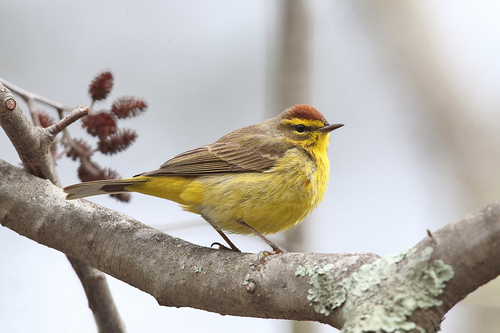
Palm Warbler
The Palm Warbler (*Setophaga palmarum*) is a small, active songbird known for its distinctive habit of constantly bobbing its tail. While not as brightly colored as some other warblers, it plays a vital role in its ecosystem, primarily as an insectivore, helping to control insect populations. This species is widespread across North America, with two distinct subspecies showing subtle differences in appearance and migratory patterns. It is not considered to have any particular cultural significance, but its common presence makes it a familiar sight for birdwatchers.
12-14 cm
Length
18-20 cm
Wingspan
Least Concern
Conservation Status
Distribution
The Palm Warbler breeds primarily in Canada's boreal forest and the northern United States, extending from the Northwest Territories east to Newfoundland. During migration, it travels through the eastern and central United States. Its wintering range includes the Southeastern United States, the Caribbean, and parts of Central America.
Lifespan
The average lifespan in the wild is not well-documented, but individuals have been known to live at least 7 years.
Palm Warbler's Habitat
Habitat Types
Boreal forests, Open woodlands, Bogs, Forest edges, Shrubby areas
Climate Zones
Boreal, Temperate, Subtropical (wintering)
Adaptations
Palm Warblers are well-adapted to foraging in dense undergrowth. Their relatively long legs and strong feet allow them to move efficiently through tangled vegetation, and their sharp, pointed bills are ideal for gleaning insects from leaves and branches.
Variations
Two subspecies are recognized: the Western Palm Warbler (*S. p. palmarum*) and the Yellow Palm Warbler (*S. p. hypochrysea*). The Western Palm Warbler has a duller plumage, with less yellow below, while the Yellow Palm Warbler is brighter yellow on the underparts. Their migratory routes also differ slightly, with Yellow Palm Warblers tending to winter further east.
Appearance
Breeding Plumage
Breeding plumage is brighter, with a rusty cap, yellow throat, and streaked breast. Non-breeding plumage is duller, with less distinct markings.
Seasonal Feather Changes
The most significant change is between breeding and non-breeding plumage. The rusty cap is less prominent or absent in non-breeding birds.
Sex Based Plumage Differences
Males generally have slightly brighter plumage, particularly during the breeding season, but the differences are subtle.
Notable Features
Constant tail-bobbing, Rusty cap (especially in breeding plumage), Yellowish eyebrow stripe, Dark eye-line
Diet and Feeding
Primary Foods
Insects, Spiders, Berries, Seeds
Foraging Behavior
Palm Warblers actively forage in low vegetation, often on the ground or in shrubs. They glean insects and other invertebrates from leaves and branches, and are known for their characteristic tail-bobbing while foraging. They may also hover briefly to pick prey from foliage.
Specializations
Their relatively long legs and sharp bill are adaptations for foraging in dense, low-lying vegetation.
Seasonal Diet Variations
During the breeding season, their diet consists primarily of insects and spiders. In the winter, they supplement their diet with berries and seeds when insects are less abundant.
Behavior
Social Structure
Palm Warblers are generally solitary or found in pairs during the breeding season. During migration and winter, they may form loose flocks, sometimes associating with other small songbirds.
Communication
Song: A simple, trilling song, often described as a buzzy *zee-zee-zee*., Call notes: A sharp *chip* or *check* call., Tail-bobbing: Used as a visual signal, possibly for communication or to flush out prey.
Migration
Palm Warblers are migratory, traveling between their breeding grounds in North America and their wintering grounds in the Southeastern US, the Caribbean, and Central America. They are relatively early spring migrants.
Territorial or Group Behaviors
Males are territorial during the breeding season, defending their nesting area from other males. During migration and winter, they are less territorial and may form loose flocks.
Conservation
Threats
Habitat loss (both breeding and wintering grounds), Pesticide use, Collisions with buildings and other structures, Climate change (potential shifts in habitat and food availability)
Protection Programs
Migratory Bird Treaty Act (protection in the US and Canada), Habitat conservation efforts in boreal forests and wintering areas
Local National Laws
Protected under the Migratory Bird Treaty Act in the United States and Canada.
Population Trend
Stable
Population Estimates
The global population is estimated to be around 12 million individuals.
Interesting Facts
Palm Warblers are one of the earliest warblers to arrive on their breeding grounds in spring.
Their early arrival allows them to take advantage of the first insect hatches.
They are often found foraging on the ground, unlike many other warbler species.
This behavior is reflected in their relatively long legs and terrestrial foraging habits.
The constant tail-bobbing is a distinctive characteristic of this species.
The exact purpose of this behavior is not fully understood, but it may serve as a communication signal or a way to flush out insects.
Faqs about Palm Warbler
What does a Palm Warbler sound like?
The Palm Warbler's song is a simple, buzzy trill. They also have a sharp 'chip' call note.
Where can I see a Palm Warbler?
During the breeding season, look for them in boreal forests and bogs across Canada and the northern US. During migration, they can be seen in a variety of habitats throughout the eastern and central US. In winter, they are found in the Southeastern US, the Caribbean, and parts of Central America.
Are Palm Warblers endangered?
No, Palm Warblers are classified as Least Concern by the IUCN. Their population is currently considered stable.
What do Palm Warblers eat?
Primarily insects and spiders, especially during breeding season. They also eat berries and seeds, particularly in winter.
Copyright @ Nature Style Limited. All Rights Reserved.
 English
English